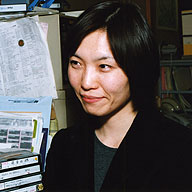An Interview with Yamauchi Yoko
I Made a Film That Serves as Therapy

Q: What prompted you to make Erotic/Girl of Worldly Desire?
YY: I was feeling anxious about getting older and having no clue about what I should do and only a fuzzy idea about marriage, amidst women my age who were getting married or doing some kind of satisfying work. So I decided to shoot my anxiety about myself and the future, and to put it together. I went on a journey asking why I like people with big bellies, and I wanted to depict marriage, motherhood and other issues particular to women, as part of the process of realizing that I want a big belly for myself. I’d be really pleased if women seeing the kinds of issues I’m dealing with can relate.
Q: The title is very memorable.
YY: Yes, it is. When I make pieces, the title is important. I want to give all my pieces titles with impact, since I want a lot of people to see my works, even if my own ideas are in the minority. This time as well, I’d decided to use the words “worldly desire,” referring to the feeling of uncertainty. But, instead of just going with “worldly desire,” I thought about having the piece reach more people. The result was the title Erotic/Girl of Worldly Desire.
Q: How did the shooting happen? Did everything go smoothly?
YY: I did almost all the shooting and editing by myself. My approach for shooting was to use my senses to film, and if I thought “I want to shoot this” I’d make a composition and film it. I didn’t start out with a script following a story. The filming itself went smoothly. If pressed for an example, at first I scripted and shot the scene where I’m talking with a friend, but I wasn’t satisfied so I changed my approach and shot us talking normally. I shot many variations of the scenes, so the filming took a long time even though the finished piece 19 minutes. Also, it took a lot of time to edit the parts that I shot following my senses.
Q: In the midst of using a very sensual approach to filming, were there any scenes that particularly left an impression, or that you paid attention to?
YY: Personally I like the scene of climbing the round rock. Also, I paid attention to make sure it didn’t become a disjointed piece, using the round rock as a departure point, and connecting the piece together through associations with round things like the wooden block used in Buddhist temples or watermelons to make it come together as a finished work.
Q: Did you have any changes in your mental attitude after making the piece?
YY: Before making the piece my parents had divorced and I had a complex about my father not being there, but this time part of me was refreshed through expressing it in a single form. If that part was there, then I think I was able to make a film that served as a kind of therapy, studying myself and soothing the complex I was feeling within myself. Also, I have done screenings at various places, and I was happy that people told me it was an interesting piece and gave me lots of different feedback.
Q: Can you give one final comment?
YY: I want many girls to see this piece. Of course I’d like guys to see it too (laugh). I’d like lots of people to see it.
(Compiled by Mikoshiba Kazuo)
Interviewers: Mikoshiba Kazuo, Kishi Yuki
Photography: Kato Takanobu / Video: Kato Takanobu / 2003-10-07 / in Tokyo
![]() Yamauchi Yoko’s website (Japanese)
Yamauchi Yoko’s website (Japanese)
